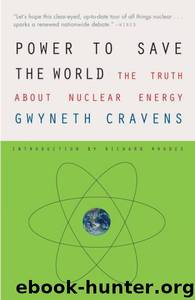Power to Save the World: The Truth About Nuclear Energy by Gwyneth Cravens

Author:Gwyneth Cravens [Cravens, Gwyneth]
Language: eng
Format: epub
Publisher: Knopf Doubleday Publishing Group
Published: 0101-01-01T00:00:00+00:00
Antinuclear advocates say that external costs such as liability insurance and effects on health and the environment must be included in calculations of the cost of nuclear power, and that therefore it's very expensive. These opponents often grumble about insurance for the nuclear industry, which they assume is paid for with tax dollars. In fact the industry is self-insured. Utilities deposit money into what is basically a savings account that is rarely drawn upon. More than $10 billion in liability insurance protection has accumulated for use in the event of a reactor incident. This insurance is governed by legislation enacted in 1957, the Price-Anderson Act, which has worked so well that it stands as a template for other similar legislation. The Nuclear Energy Institute defines the arrangement as follows:
Insurance pools have paid more than $200 million in claims and litigation costs since the act went into effect. They disbursed approximately $71 million of that total in claims and litigation costs related to the 1979 accident at Three Mile Island 2…. The Price-Anderson Act provides no-fault insurance to benefit the public in the event of a nuclear power plant accident the Nuclear Regulatory Commission deems to be an “extraordinary nuclear occurrence.” The costs of this insurance, like all the costs of nuclear-generated electricity, are borne by the industry, unlike the corresponding costs of some other power sources. Risks from hydropower mishaps (dam failure and resultant flooding), for example, are borne directly by the public. The 1977 failure of the Teton Dam in Idaho caused $500 million in property damage, but the only compensation provided to those affected was about $200 million in low-cost government loans.
Under the Price-Anderson framework, the public has paid nothing. … The act has proven so successful that Congress has used it as a model for legislation to protect the public against potential losses or harm from other hazards, including faulty vaccinations, medical malpractice and toxic waste.
Download
This site does not store any files on its server. We only index and link to content provided by other sites. Please contact the content providers to delete copyright contents if any and email us, we'll remove relevant links or contents immediately.
| Automotive | Engineering |
| Transportation |
Whiskies Galore by Ian Buxton(41525)
Introduction to Aircraft Design (Cambridge Aerospace Series) by John P. Fielding(32885)
Small Unmanned Fixed-wing Aircraft Design by Andrew J. Keane Andras Sobester James P. Scanlan & András Sóbester & James P. Scanlan(32569)
Craft Beer for the Homebrewer by Michael Agnew(17928)
Turbulence by E. J. Noyes(7694)
The Complete Stick Figure Physics Tutorials by Allen Sarah(7135)
Kaplan MCAT General Chemistry Review by Kaplan(6591)
The Thirst by Nesbo Jo(6432)
Bad Blood by John Carreyrou(6271)
Modelling of Convective Heat and Mass Transfer in Rotating Flows by Igor V. Shevchuk(6219)
Learning SQL by Alan Beaulieu(6029)
Weapons of Math Destruction by Cathy O'Neil(5824)
Man-made Catastrophes and Risk Information Concealment by Dmitry Chernov & Didier Sornette(5643)
Digital Minimalism by Cal Newport;(5388)
Life 3.0: Being Human in the Age of Artificial Intelligence by Tegmark Max(5182)
iGen by Jean M. Twenge(5158)
Secrets of Antigravity Propulsion: Tesla, UFOs, and Classified Aerospace Technology by Ph.D. Paul A. Laviolette(4980)
Design of Trajectory Optimization Approach for Space Maneuver Vehicle Skip Entry Problems by Runqi Chai & Al Savvaris & Antonios Tsourdos & Senchun Chai(4837)
Electronic Devices & Circuits by Jacob Millman & Christos C. Halkias(4741)
